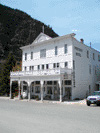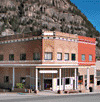February 13, 2015
Ouray Walking Tour
 Circle Ouray in one and one-half miles. From Oak Street to Vinegar Hill and downtown, history is alive. Many of the old homes you see are still privately owned and lovingly maintained. Most of the commercial buildings remain much as they were a century ago, at least in outward appearance, allthough all of them now offer modern ammenities.
Circle Ouray in one and one-half miles. From Oak Street to Vinegar Hill and downtown, history is alive. Many of the old homes you see are still privately owned and lovingly maintained. Most of the commercial buildings remain much as they were a century ago, at least in outward appearance, allthough all of them now offer modern ammenities.
In 1881, Charles and Abbies Wheeler built a cabin on Oak Street overlooking Ouray and the magnificent Amphitheater to the east. The delightful log home is described by Sandra Dallas in her 1965 book, “Gaslights and Gingerbread,” as an “;add-on house of charm and beauty.”
 Walk down the Oak Street hill and cross the Uncompahgre River at the Seventh Avenue bridge to approach early Ouray’s once-bustling “red-light” district. Imagine Second Street lined with rows of brothels, little houses called “cribs” and saloons, one of them called “The Temple of Music.” The buildings are mostly gone now, but their history is well preserved through writings and photography.
Walk down the Oak Street hill and cross the Uncompahgre River at the Seventh Avenue bridge to approach early Ouray’s once-bustling “red-light” district. Imagine Second Street lined with rows of brothels, little houses called “cribs” and saloons, one of them called “The Temple of Music.” The buildings are mostly gone now, but their history is well preserved through writings and photography.
On the north side of Ninth Avenue is a log cabin, painted red, known as the Raab/Sly cabin. It was built on the Mephistopheles Lode, an early mine claim. No records exist to describe its early inhabitants or the exact time it was built. Johnny Raab purchased it in the late 1890s, later selling it to a friend named Sly, then to Bob and Karen Risch. The tree bark is preserved on some logs.
 Next, visit the Western Hotel, a beautiful three-story, white frame hotel on Seventh Avenue with Italianate accents. Erected in 1891 by premier builder Francis Carney, the hotel survived Ouray’s several devastating fires. It is one of the few hotels of its kind left in the United States. Although the Western was in direct proximity to the red-light district, it never operated to serve other than an upstanding clientele. A hotel until 1916, when it became a boardinghouse, then later a small historical museum, today the Western offers rooms, a fine bar and a dining room which serves wonderful food. A special feature is the “face on the barroom floor.” Stop in and see it; owners Greg and Rose Marie Pieper welcome visitors.
Next, visit the Western Hotel, a beautiful three-story, white frame hotel on Seventh Avenue with Italianate accents. Erected in 1891 by premier builder Francis Carney, the hotel survived Ouray’s several devastating fires. It is one of the few hotels of its kind left in the United States. Although the Western was in direct proximity to the red-light district, it never operated to serve other than an upstanding clientele. A hotel until 1916, when it became a boardinghouse, then later a small historical museum, today the Western offers rooms, a fine bar and a dining room which serves wonderful food. A special feature is the “face on the barroom floor.” Stop in and see it; owners Greg and Rose Marie Pieper welcome visitors.
As you walk east, uphill, across the city, note the interesting buildings, some with amazing histories. Ahead, you will see a charming, brick one-and-a-half-story home, first owned by Gus Arps, an enterprising young man at the turn of the last century. He was president of Arps Hardware store. Believe it or not, the multi-colored bricks used to build this Victorian cottage were discovered to be a foot thick.
Between Sixth and Fifth Avenues walk further uphill on Fifth Street, or “Vinegar Hill.” The area got its name in 1875 when thirteen men, the first newcomers to the Ouray Valley, supposedly drank vinegar with their Christmas dinner in lieu of alcohol. (The latter was unavailable.) The men, drunk on vinegar, apparently had a merry old time and no doubt had some trouble traveling on the hill.
 Keep going to the Portland Flume. See the Backlog cabin set back along the alley close to the flume. Probably this was the first cabin built in Ouray, then a tiny mining camp called Uncompahgre, and it most certainly was the site of Ouray’s first Christmas dinner.
Keep going to the Portland Flume. See the Backlog cabin set back along the alley close to the flume. Probably this was the first cabin built in Ouray, then a tiny mining camp called Uncompahgre, and it most certainly was the site of Ouray’s first Christmas dinner.
 Head down to Main Street. (In Ouray, north and west are both downhill!) Next to the historic Wright Opera House on Main, you will see the St. Elmo Hotel, built in 1891 by frontier entrepreneur Kittie Heit. (She also owned the original Bon Ton Restaurant, quite a feat in a town dominated by men of stature.) The old Bon Ton is gone now, replaced by a lovely courtyard, but the restaurant lives on in the lower level of the hotel, now owned by the Lingenfelter family. Step inside, enjoy the Victorian elegance of the lobby and dine in the restaurant, as it serves delicious foods and libation.
Head down to Main Street. (In Ouray, north and west are both downhill!) Next to the historic Wright Opera House on Main, you will see the St. Elmo Hotel, built in 1891 by frontier entrepreneur Kittie Heit. (She also owned the original Bon Ton Restaurant, quite a feat in a town dominated by men of stature.) The old Bon Ton is gone now, replaced by a lovely courtyard, but the restaurant lives on in the lower level of the hotel, now owned by the Lingenfelter family. Step inside, enjoy the Victorian elegance of the lobby and dine in the restaurant, as it serves delicious foods and libation.
 On the corner of Fifth Avenue and Main Street stands the impressive Beaumont Hotel. The building took shape in 1886 and was finished in 1887. The Grand Opening occurred July twenty-fifth. Enter the hotel through Bulow’s Bistro at the courtyard. Visit the hotel lobby and see the restored opulence created by new owners who returned this grand lady to her original beauty. The lobby is awesome with its original registration desk and a beautiful Chickering square grand piano near the grand staircase. The piano is owned by the Ouray County Historical Society. Several main floor retail businesses are open, including a bookstore, jewelry store and combination art gallery and jewelry store. Upstairs, the elegant Tundra Restaurant serves fine foods.
On the corner of Fifth Avenue and Main Street stands the impressive Beaumont Hotel. The building took shape in 1886 and was finished in 1887. The Grand Opening occurred July twenty-fifth. Enter the hotel through Bulow’s Bistro at the courtyard. Visit the hotel lobby and see the restored opulence created by new owners who returned this grand lady to her original beauty. The lobby is awesome with its original registration desk and a beautiful Chickering square grand piano near the grand staircase. The piano is owned by the Ouray County Historical Society. Several main floor retail businesses are open, including a bookstore, jewelry store and combination art gallery and jewelry store. Upstairs, the elegant Tundra Restaurant serves fine foods.
 Further north, at the corner of Sixth Avenue and Main Street is the Citizens State Bank Building. This 1899 Queen Anne/ Romanesque structure, at the heart of downtown Ouray, was first called the Prevost Building and was originally occupied by the Manion and Beavers Saloon. The elevated sidewalk on the building’s south face was constructed to allow ladies to bypass the saloon when doing business here. Also, near the main doors to the bank, are two gold ore bricks that were used for decoration. At one time, when someone wanted that ore, the bricks were chiseled a bit in an attempt to liberate them, but as you see they remain.
Further north, at the corner of Sixth Avenue and Main Street is the Citizens State Bank Building. This 1899 Queen Anne/ Romanesque structure, at the heart of downtown Ouray, was first called the Prevost Building and was originally occupied by the Manion and Beavers Saloon. The elevated sidewalk on the building’s south face was constructed to allow ladies to bypass the saloon when doing business here. Also, near the main doors to the bank, are two gold ore bricks that were used for decoration. At one time, when someone wanted that ore, the bricks were chiseled a bit in an attempt to liberate them, but as you see they remain.
Your tour is over and perhaps you wish the saloon were still open for refreshments after your circle tour of Ouray. The bar may be a bank now, but there are numerous places in the downtown area to rest, eat and drink, both indoors and out. Visit the many eclectic shops or sit on the benches to take in the amazing scenic beauty that surrounds the city.
If interested in other tours, check out the self-guided tour in the Ouray Chamber Resort Association Visitor Guide, or contact the Ouray County Historical Society for distinctly different guided tours, which will focus on interesting and colorful characters from Ouray’s past.
Story by Ann Hoffman. Photography © James Burke, Kathryn R. Burke
Site and Page content: Copyright San Juan Publishing Group, Inc. All rights reserved.
